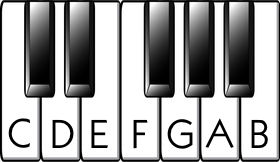This simple piano notes chart is designed to help beginners find their way around the piano keyboard. If you’re just getting familiar with the piano keyboard, all you need to do is recognize this pattern of black keys:

As described in the article Layout of Piano Keys, this pattern of groups of two and three black keys repeats itself over and over. All you need to do is learn this pattern, and you’ll be able to find any key on the piano using the piano notes chart.
But here’s an essential point which you probably won’t learn elsewhere: The piano keys don’t “really” have names. They’re just keys, not notes. (The article Piano Key Chart explains this concept in more detail.) The only exception is middle C, which is (roughly) in the middle of the piano keyboard, and that is only by convention.
I understand that this may be confusing at first, but it’s a good idea to understand this concept now; otherwise learning sharps and flats on the piano will be unnecessarily confusing later on.
The piano keyboard is relative, and it has to be relative to something, so let’s take middle C as our starting point. To orient yourself with the piano keyboard, find the first white key to the left of the group of two black keys, in the middle of the keyboard. That’s middle C:

Play middle C. Now play the next seven white keys in succession, going up the keyboard (to the right). It should sound like this:
This last key you played is also C, one octave higher. This is where the pattern of keys repeats itself. You just played a C major scale, in fact. Here are the note names for the C major scale:

Take “note” of these note names, since they will orient you on the piano keyboard. This, then, will serve as your piano notes chart.
What’s interesting is that these keys aren’t actually called C, D, E, etc. They just play those notes. The same keys also play other notes. For instance, we could play a B-sharp major scale, in which you’d play the exact same keys on the piano, but this time all the keys would correspond to entirely different notes, starting with B-sharp. And of course on the piano C major and B-sharp major sound exactly the same, since they’re played using the exact same keys.
The black keys
This leads us to the black keys… which leads us to accidentals. “Accidentals” are by design… they’re no accident. They’re the sharps and flats. A sharp means to play the next higher key on a piano, while a flat means to play the next lower key. Thus, the key immediately to the right of middle C is C-sharp. But it is also D-flat, since it is immediately to the left of D.
Exercise: See if you can name notes that correspond to the black keys. For a more advanced exercise, try to find alternate names for the white keys! I’ll give you a hint: Notes are not necessarily limited to just one sharp or flat….
Summary
Let’s summarize the piano notes chart. All you need to understand for now are the following few points:
- The groups of two and three black keys
- Middle C
- The letters A through G
- Sharps and flats are instructions to play the next higher and lower keys, respectively
Now that you’ve familiarized yourself with the piano keyboard, you’ll longer need the piano notes chart. For the next step (and the answers to the exercise), it’s time to move on to the Piano Key Chart.
Start Your NEW Piano Journey
Sign up below and each week for the next year, I'll send you a professional 3- to 5-minute lesson sharing exclusive playing and practice techniques used by concert artists worldwide.
Each lesson has been carefully crafted to meet the needs of players ranging from beginners to the late intermediate level.
We will never sell your information, for any reason.

